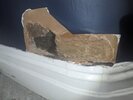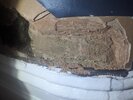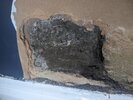- Joined
- 29 Jun 2023
- Messages
- 83
- Reaction score
- 2
- Country

125 year old Victorian terrace and had penetrating damp on external wall, cracked soil pipe now fixed, and damp/ salts coming through a small amount into internal lounge wall. Stripped paint off but salts still appearing through plaster.
I have now chipped away the smalls section of plaster expecting to see brick but I have come across a slab of concrete on one side and some black crumbly stuff on the other. Having looked behind the black stuff, I can see the red brick about 1.5inches back.
In order to fully let that part of the wall dry out, can I let it dry out as is now the contimainted plaster has gone for a few months and then re-plaster with salt resistant plaster?
Or do I need to fully strip it back to brick, take concrete and black stuff off, which will create a gigantic hole to then have to fill back in before plastering?
I have now chipped away the smalls section of plaster expecting to see brick but I have come across a slab of concrete on one side and some black crumbly stuff on the other. Having looked behind the black stuff, I can see the red brick about 1.5inches back.
In order to fully let that part of the wall dry out, can I let it dry out as is now the contimainted plaster has gone for a few months and then re-plaster with salt resistant plaster?
Or do I need to fully strip it back to brick, take concrete and black stuff off, which will create a gigantic hole to then have to fill back in before plastering?






